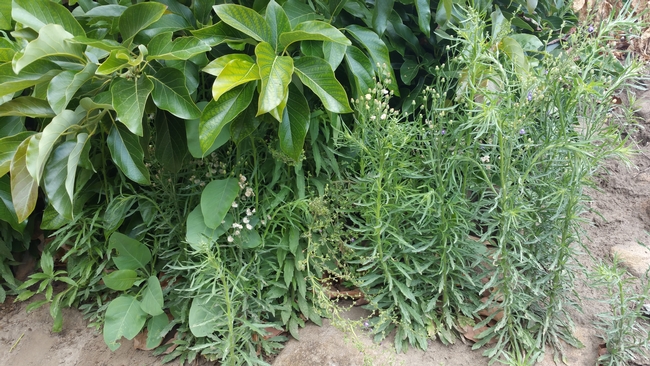
Posts Tagged: subtropical tree crops
Weed Control in Subtropical Tree Crops
Control of weeds has always been a major economic cost in subtropical fruit production because of favorable climate that allows for weed germination and year-round growth. The use of chemical weed control has increased dramatically due to labor costs, equipment costs, product costs and availability, the shift to more narrowly spaced tree rows, and installation of low volume irrigation systems that prohibit the operation of mowing or tillage equipment under the tree canopy area (Futch 2001).
However finding herbicides that are labeled for certain subtropical crops can be a bigger challenge. UC Weed Science has updated the Subtropical Crops herbicides usage chart for California growers (Fig. 1 Attachment below). It also seems that preventive programs are most frequently overlooked as a method of weed control. Preventive programs entail the use of such practices as sanitation, spot spraying, or hand labor to prevent the source of weed infestation (seed and/or vegetative) from widespread dissemination throughout a given area. By removing the undesirable weed species prior to seed development, dissemination by wind or mechanical transport on equipment can be effectively delayed.
Weed control programs will vary from location to location within the state and can even vary within a given site based upon specific conditions such as soil type, variety, method of herbicide application, and the presence of specific weed species.
Before herbicide application, growers should survey the grove and determine the stage of growth and type of weeds for that given location. Many products do not provide control of emerged species, thus requiring the application of more than one product to provide both preemergence and postemergence protection (Futch 2001). Rotation of soil-applied herbicides should also be considered to prevent the buildup of resistant annual and perennial weeds. The resistant species may not be evident initially; however, if the same herbicide and cultural program is maintained, over time their populations may build up until they infest the entire grove and become the dominant weed species (Jordan et al 1992).
Herbicide damage to foliage and fruit has also been noted when herbicides were applied under windy conditions or use of improper equipment allowed the materials to contact areas other than the weeds or soil. Please make sure to follow the label's direction and use caution.
Attached below is a chart listing herbicides registered for avocado, citrus, date, kiwi, fig and pomegranate.
Figure 1. Herbicide Registration on CA Subtropical Crops
Year Round IPM Guides
About the Year-Round IPM Programs

 The video tour
The video tour
Guided tour of the year-round IPM programs for field, orchard, and vineyard crops. (Detailed outlinewith links to examples)
- Introduction (3 min)
- Prevention (3 min)
- Pest identification (4.5 min)
- Monitoring (5 min)
- Management decisions
(6 min) - Management methods
(6.5 min) - Environmental concerns and summary (8 min)
 Almond
Almond
Guided video tour on how to manage pests using the Almondyear-round IPM program.
- Introduction (2.5 min)
- Dormancy and delayed-dormancy (7 min)
- Bloom to postbloom (7 min)
- Fruit development (8.5 min)
- Harvest and postharvest
(3.5 min) - Pesticide application checklist
(5 min)
A year-round IPM program ![]() is an annual plan of action you can use to implement integrated pest management and evaluate its success.
is an annual plan of action you can use to implement integrated pest management and evaluate its success.
For each season or crop growth stage, these programs highlight the most important pests—insects, mites, weeds, diseases, nematodes, animals—and actions you can take to manage them.
Year-round IPM programs are based on the UC Pest Management Guidelines, the University of California's best information for managing agricultural pests.
A year-round IPM program will help you:
- Eliminate pesticide treatments you don't need
- Minimize risks to water and air
- Protect beneficials and pollinators
A year-round IPM program includes:
- Management activities for key pests at each stage of crop development
- Pointers to key environmental concerns
- Examples of monitoring forms to print and use
- Printable color photo guides to pests and beneficials
- Ways to minimize harm from pesticides
Each year-round IPM program provides links to:
- Pest monitoring instructions and decision thresholds
- Nonchemical and pesticide alternatives for each pest
- Information on pesticide mode of action and impact on beneficials
- A comparison of chemical options and their risks
Natural Resources Conservation Service plans
A year-round IPM program can be the foundation for integrated pest management plans, such as those supported by USDA Natural Resource Conservation Service (NRCS) conservation programs. For more information, contact your local NRCS office.
Figure below. Avocado black streak is a disease that can be managed with irrigation, as described in the Year Round IPM Program for avocado.

black streak


